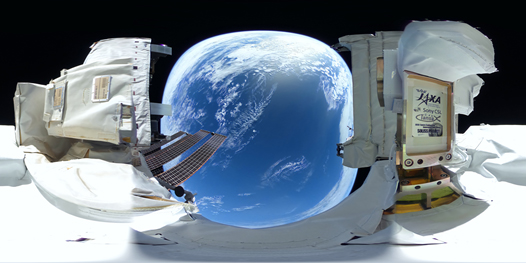JAXA and Ricoh release 360-degree spherical pictures and videos captured in outer space
TOKYO, Japan – October 17, 2019 – Ricoh Company, Ltd., (Tokyo, Japan) today announced that the 360-degree spherical camera jointly developed with Japan Aerospace Exploration Agency (JAXA) successfully captured 360-degree spherical pictures and videos in outer space. The pictures and videos were released today.
The camera was installed to monitor the operation of the biaxial gimbal of the SOLISS (Small Optical Link for International Space Station)*1 . It was carried aboard the H-II Transfer Vehicle (HTV8) “KOUNOTORI-8”, the cargo transporter to the International Space Station (ISS), which was launched on September 25th, 2019. The camera shot spherical pictures and videos from the Exposed Facility of the Japanese Experiment Module (JEM) “Kibo” and which were then sent to ground stations. This camera was developed from a consumer product and is the world’s smallest 360-degree camera that can be used in outer space. This is the first time that this 360-degree camera took spherical images in outer space.
The camera was based on Ricoh’s compact spherical camera RICOH THETA*2, and JAXA has modified this camera so it could be used in space and withstand the heat and radiation. Given the camera’s compact size and light weight, as well as the fact that the camera can shoot 360-degree spherical images in a single shot, it has proved very useful when capturing a lot of visual information whilst in outer space.
The pictures and videos will be available via the JAXA Digital Archives (JDA). Also in Ricoh’s THETA LAB, the pictures and videos can be viewed as 360-degree images via a web browser. You can also simulate the experience of being in outer space using a VR headset.
Ricoh will continue expand the use of its 360-degree cameras and related services to a wide variety of industries. It will also contribute to the development of science and society, including space development, through technology research and development.

Spherical image shot in outer space (converted to flat image)
*1 Small Optical Link for International Space Station: JAXA and Sony Computer Science Laboratories, Inc. jointly developed a long-distance laser communication system under the Request for Proposal (RFP) joint study framework of the JAXA Space Exploration Innovation HUB Center*3, with the aim of establishing a real-time, mass-data communication system for future inter-satellite communications and communications with ground stations.
*2 RICOH THETA external dimensions (excluding lens): 44mm (W) x 130mm (H) x 22.9mm (17.9mm) (D)
*3 A project which JAXA has been commissioned by the Japan Science and Technology Agency (JST) under its innovation hub start-up program. (“Open Innovation Hub for Expanding Humanosphere and the Domain of Human Activity through Solar System Frontier Development”)
###
JAXA Digital Archives
JAXA Space Exploration Innovation Hub Center
http://www.ihub-tansa.jaxa.jp/english/index.html
THETA LAB
https://www.thetalab.ricoh/en/
JAXA and Ricoh jointly develop a compact spherical camera for use in outer space
https://www.ricoh.com/release/2019/0828_1/
About Ricoh
Ricoh is empowering digital workplaces using innovative technologies and services enabling individuals to work smarter. For more than 80 years, Ricoh has been driving innovation and is a leading provider of document management solutions, IT services, commercial and industrial printing, digital cameras, and industrial systems.
Headquartered in Tokyo, Ricoh Group operates in approximately 200 countries and regions. In the financial year ended March 2019, Ricoh Group had worldwide sales of 2,013 billion yen (approx. 18.1 billion USD). For further information, please visit www.ricoh.com.
News & Events
Keep up to date
- 18Dec
Ricoh recognised as a Top 5 global AV Integrator in SCN Top 50 Systems Integrators 2025
- 11Dec
Ricoh Recognised as a Sustainability Leader in Quocirca's 2025 Report
- 31Oct
Ricoh perovskite solar cells installed on Japan Aerospace Exploration Agency cargo transfer spacecraft1 HTV-X1
- 17Oct
Ricoh recognised among Forbes’ World’s Best Employers 2025
